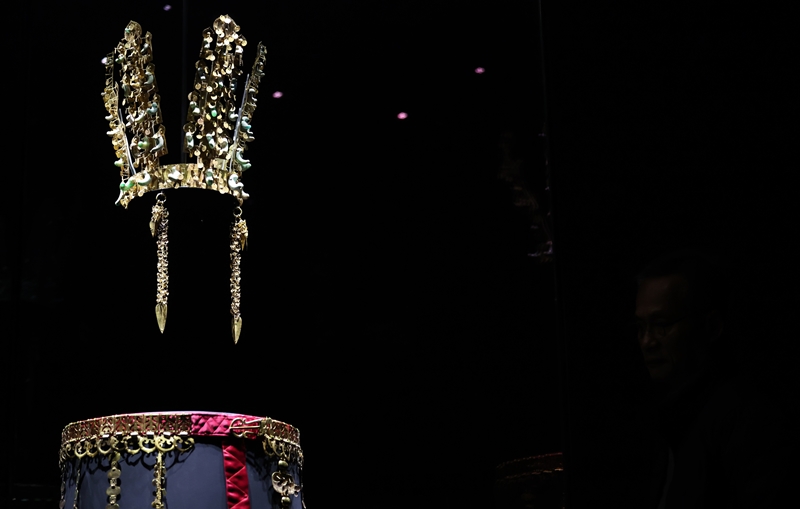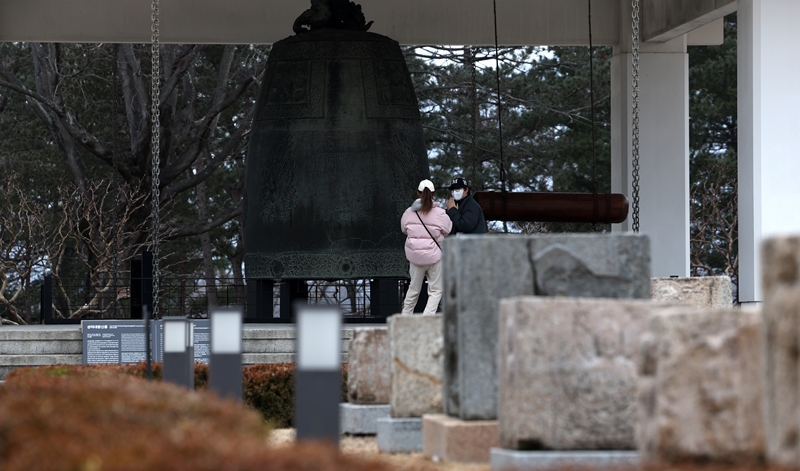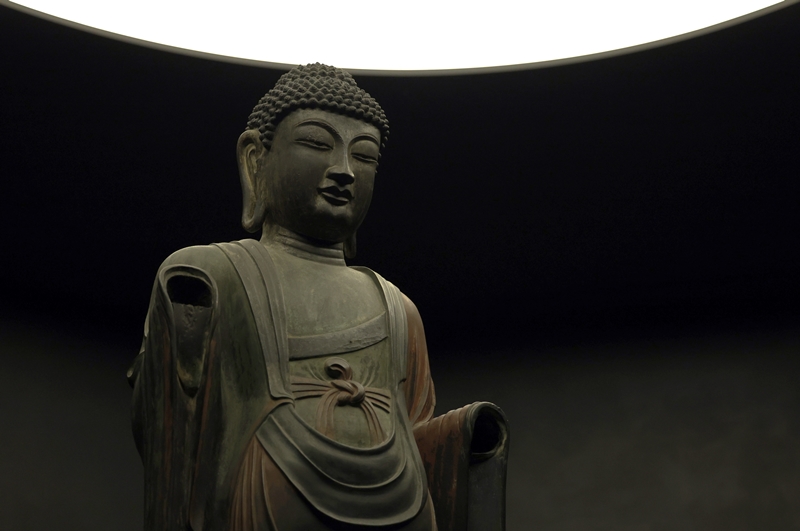박물관은 한 나라의 역사와 문화가 살아 숨 쉬고 과거와 현재, 미래가 공존하는 공간이다. 또한 그 나라의 문화의 힘을 확인할 수 있는 장소이기도 하다. 코리아넷이 대한민국의 지역별 국립박물관 6곳을 선정, 그곳에서 놓쳐선 안될 대표 소장품을 소개한다. 국립중앙박물관에 이어 두 번째로 신라의 문화유산을 한 눈에 살필 수 있는 국립경주박물관으로 가본다.
A museum is where a country's history and culture live and breathe and the past, present, and future coexist, as well as showing the nation's cultural power. Korea.net has selected six national museums by region to introduce leading must-see works displayed at each. Debuting with the National Museum of Korea, this series presents its second part, Gyeongju National Museum, which shows the cultural heritage of the ancient Silla Kingdom at a glance.
1. 마립간의 권위와 신성함을 보여주는 ‘금관’ - Gold crown symbolizing authority and sacredness of the Silla king

▲ 신라는 마립간이라는 지배자를 중심으로 고대 국가의 틀을 갖추기 시작했는데 왕과 왕족, 최고 귀족들만 독점적으로 황금장신구를 소유했다고 한다. 그들에게 황금은 곧 권력의 상징이었고 특히 ‘금관’은 그 중에서도 최고 권위자만이 쓸 수 있었던 위세품이었다. The ancient Silla Kingdom began to center its framework on its maripgan (monarch), with gold jewelry meant only for the king, royal family, and high-ranking aristocrats. To them, gold symbolized authority and the gold crown was reserved for only the highest authority.
박물관 내 신라역사관 제2전시실에는 유독 사람들이 몰리는 곳이 있다. 멀리서도 ‘우와~'하는 감탄사가 들려오는 그곳에는 눈부신 황금빛을 뿜어내는 신라시대 ‘금관’이 전시돼 있다.
A section at Silla History Gallery, the second exhibition hall of the Gyeongju National Museum, in Gyeongju, Gyeongsangbuk-do Province, is especially popular with visitors. The section houses a gold crown from the ancient Silla Kingdom, and the relic's dazzling golden lights evoke oohs and ahs from afar.
우뚝 솟은 나뭇가지와 사슴뿔 모양 장식. 거기에 동글동글한 달개와 태아 모양의 비취색 곡옥(曲玉)이 금실에 엮여 빼곡하게 매달려 있다. 그것도 모자라 금관 좌우에는 드리개가 길게 늘어져 있고, 금관의 주인공을 더 화려하게 꾸며줄 허리띠까지. 과연 ‘황금의 나라’라 불린 신라답게 모든 게 금이다.
The crown's decorations feature high-towering branches and deer antlers plus round moon stones and celadon-colored jade woven into a hanging gold thread. Moreover, long pendants hang on the left and right sides of the crown, as well as a belt that adds even more extravagance to the crown wearer.
이 금관은 경상북도 경주시 황남동 천마총에서 출토된 것으로 무덤의 주인은 500년 전후에 살았던 왕 또는 최고 왕족으로 추정된다. With Silla known as "the country of gold," everything about the crown is made of the precious metal.
김대환 국립경주박물관 학예연구사는 관람할 때 가장 중요한 포인트로 금관의 ‘의장’(디자인)을 꼽는다. 금관의 나뭇가지 모양에 대해 “고대사회에서 나무는 하늘과 땅을 이어주는 신성한 존재로 여겼다”며 “신라의 왕들은 자신의 권력 역시 신성한 것이라 과시하기 위해 나무에서 모티브를 가져왔다”고 설명했다. 금관을 쓰고 움직이면 달개와 곡옥이 흔들리면서 소리가 나는데 이것 역시 지배자의 위엄을 나타내는 거라고.
Kim Daehwan, associate curator at the Gyeongju National Museum's Curatorial Affairs Office, said the most important thing to look for in the crown is the design. On the relic's tree branch designs, he said trees were "considered sacred entities in ancient times that connected heaven and Earth."
"Silla monarchs brought motifs from trees to flaunt the sacredness of their authority," Kim said, adding that the crown makes sounds when worn or moved as the moonstones and ornamental beads shake to symbolize the ruler's dignity.
전 세계에서 출토된 금관은 10여 개 정도인데 그 중 무려 6점이 신라시대의 금관이다. 6점 가운데서도 이곳 국립경주박물관에 전시되어있는 금관이 가장 호화스럽고 발전된 모습을 보여준다.
Of the some 10 gold crowns excavated worldwide, six of them are from the Silla Kingdom. The most extravagant and advanced of the six is housed at the Gyeongju Museum.
화려하디 화려한 금관을 쓰고 귀걸이, 목걸이, 허리띠, 신발까지 황금으로 두른 채 자신의 권력을 뽐냈을 당시 왕과 왕족의 모습을 상상해 보는 것도 좋은 관람 방법 중 하나가 될 듯하다.
One of the best ways to see the crown is to imagine the Silla king and royal family wearing the fancy gold crown and everyone dressed in gold including earrings, necklaces, belts, and even shoes to show off their power.
2. 아름답고도 긴 여운을 남기는 종소리, ‘성덕대왕신종’ - Beautiful and long-lasting chimes of the Sacred Bell of King Seongdeok

▲ 1962년 국보로 지정된 '성덕대왕신종'을 두고 독일의 한 저명한 학자는 “이 종 하나만으로 박물관을 지을 수 있을 정도”라고 평가하기도 했다. A prominent German scholar said the Sacred Bell of King Seongdeok, which was designated a National Treasure in 1962, alone could make a museum.
박물관 정문을 지나 안뜰로 들어서면 바깥에 전시돼 있는 커다란 종이 보인다. 신라 최고의 기술자들이 만들어 낸 높이 366cm, 무게 18.9톤에 이르는 '성덕대왕신종'이다.
Pass the museum's front gate and enter the courtyard to see a large outdoor bell. The Sacred Bell of King Seongdeok is 366 cm tall, weighs 18.9 tons, and was made by the finest Silla craftsmen.
신라 제35대 왕인 경덕왕이 돌아가신 아버지 성덕대왕을 위해 만들기 시작해 아들인 혜공왕에 의해 완성된 종으로 '봉덕사종', ‘에밀레종’이라 불리기도 한다.
King Gyeongdeok, Silla's 35th monarch, had the bell made for his father, King Seongdeok. Completed during the reign of Gyeongdeok's son and successor Hyegong, the relic is also known as the "Bell of Bongdeoksa Temple" and "Emile Bell."
종의 가장 위 끝에 있는 종뉴(큰 종을 매다는 고리)는 용이 여의주를 물고 있는 모습을 하고 있다. 밑으로 내려와 종의 몸체를 살펴보면 위에는 보상당초무늬와 연꽃 무늬가, 그 아래에는 종의 백미라 할 수 있는 아름다운 '비천상'이 새겨져 있다.
At the loop on top of the bell is a dragon holding a yeouiju, or the wish-fulfilling jewel cintamani. Further down the body of the bell are bosang arabesque and lotus flower patterns, and below those is a beautiful bicheon, or a heavenly Buddhist being apsara, and the highlight of the bell.

▲ 성덕대왕신종에 새겨져 있는 ‘비천상’의 모습. 성덕대왕신종을 만들 때 어린 아이를 같이 넣었다는 전설이 있었지만 실제 종의 재질을 과학적으로 분석해본 결과 이는 사실이 아닌 것으로 밝혀졌다. 그만큼 만들기 어려웠다는 걸 상징적으로 보여주기 위한 것으로 풀이된다. The image of a bicheonsang (heavenly Buddhist being) is on the Sacred Bell of King Seongdeok. Legend has it that the body of a child was used to make the bell, but scientific analysis has disproved this notion, which might have been made up to reflect the difficulty of the relic's production.
'비천'은 불교에서 말하는 하늘을 날아다닌다는 여자 선인으로, 무릎을 꿇은 채 무언가를 간절히 빌며 하늘로 올라가는 듯한 모습을 하고 있다. 이현태 학예연구사는 "종소리를 통해 하늘과 땅을 연결시켜 주고 그것을 비천상으로 형상화한 것"이라고 해석한다.
In Korean Buddhism, a bicheon is a female hermit who flies across the sky and apparently ascends toward heaven while kneeling and earnestly praying for something. Curator Lee Hyuntae said, "This image of a bicheon embodies the connection between heaven and Earth through the sounds of a bell."
종에 새겨진 무늬는 좌우가 정확히 대칭을 이루고 있는 것 역시 특징. 좌우로 한 쌍씩, 모두 네 상이 부조돼 있는데, 이 학예연구사는 “남아있는 종 중에 이렇게 큰 종도 없지만 지금 당장 디자인으로 활용해도 손색이 없을 정도”라며 "통일신라 과학 기술의 총집합체"라고 설명했다.
Another highlight is the precise symmetry of the bell's left and right designs. Both sides each have a pair of reliefs depicting mythological women for a combined four on the bell. "No bells this large have survived but this incomparable bell today can be used for design purposes," Lee said, calling the bell a "collection of Unified Silla's science and technology."
비록 녹음된 것이긴 하지만 매시 20분 간격으로 종소리를 들을 수 있다. 은은하게 꽤 오랫동안 울려 퍼지는 종소리를 들으며 비천상을 바라보고 있노라면 마음이 편안해지는 걸 느낄 수 있다.
The bell's recorded sound can be heard every two 20 minutes on the hour. Visitors can ease their minds while listening to the soft and long-lasting bell chimes and looking at the bicheon image.
3. 아픈 사람을 낫게 해주는 ‘약사여래’ - Medicine Buddha: healer of illness

▲ '약사여래'는 통일신라시대 800년 전후 경에 제작한 것으로 알려져 있으며 국보로 지정돼 있다. This National Treasure-designated Medicine Buddha statue is believed to have been made around 800 A.D.
불교에서 약사여래는 모든 질병을 치료해 주고 수명을 연장해 주며 사람들의 생활에 직접적인 이익을 주는 부처로 널리 알려져 있다. 박물관 신라미술관 불교조각 3실에 있는 '약사여래'가 많은 이들의 사랑을 받고 있는 것도 그러한 연유에서다.
Yaksayeorae, or the Medicine Buddha, is widely known to heal the sick, extend human life, and directly benefit people's lives. This is why the Medicine Buddha at Buddhist Sculpture Gallery 3 of the museum's Silla Art Gallery is so beloved.
높이가 180cm에 가까운 큰 체구의 '약사여래'는 조형적으로 완성미가 뛰어나지만 두 손이 없다. 팔을 든 자세와 사진으로 남아있는 옛 자료를 통해 약단지로 보이는 물체를 왼손에 든 모습으로 보아 약사여래라 추정하고 있다.
This large sculpture is 180 cm tall and boasts striking craftsmanship but lacks hands. Based on its raised-arm posture and old photos, the Medicine Buddha is believed to have held an item in his left hand.
신명희 학예연구사는 약사여래의 뒷면을 눈 여겨 보길 추천한다. 불상의 뒤를 살펴보면 정수리와 머리, 등 뒤에 커다란 구멍이 있는데, 이는 불상을 만든 뒤 내형토(內型土)를 제거할 때 사용했다. 고도의 기술이 없으면 이러한 대형 불상을 만들기 어렵기에 그 과정에서 필요한 요소들이 불상의 뒷면에 보인다는 것.
Curator Shin Myung-Hee recommended looking at the back of the statue, citing the large holes on the top of the head, head, and back that were used to remove inner soil after the statue's creation. Because making such a large statue was difficult without advanced technology, the necessary elements of the process are visible on the back.
그러면서 "박물관에 오시거든 부디 약사여래를 만나 자신과 가족의 건강을 빌어보시길 바란다"고 전했다. "If you visit the museum, please meet the Medicine Buddha and pray for your health and that of your family," she said.
# 국립경주박물관 더 즐기기 - Tips to best enjoy Gyeongju National Museum
- 금관이 출토된 천마총을 직접 방문해보는 건 어떨까. 천마총은 내부를 들여다볼 수 있게 돼 있는데 출토된 현장을 복원해 놓은 모습도 볼 수 있다. 박물관에서 천마총까지 걸어서는 20분 정도가 소요된다. 먼 거리는 아니지만 걸어가기는 조금 힘들다. 버스는 배차간격이 길어 택시 이용을 추천한다. 출발하자마자 “다 왔심더”하는 택시 기사님의 농담 섞인 이야기를 구수한 경상도 사투리로 들을 수 있는 재미도 있다.
- Visit Cheonmachong Tomb, where the gold crown was unearthed. Visitors can look inside this royal tomb and see the restored excavation site. A walk from Gyeongju National Museum to Cheonmachong takes about 20 minutes, not that far but a bit tiring. Bus intervals are along so taking a taxi is recommended. Those fluent in Korean can hear a cabbie's jokes and the classic Gyeongsang-do accent while riding.
- 밤에 박물관을 찾는 것도 좋겠다. 조명을 받은 성덕대왕신종의 비천상이 금방이라도 튀어나와 날아갈 것 같은 모습을 볼 수 있다. 야간개장은 매달 마지막 주 수요일, 3~12월 매주 토요일 10:00~21:00.
- Going to the museum at night is also advised to see the illuminated bicheon image on the Sacred Bell of King Seongdeok; she looks as if it will pop out and fly. The museum has extended evening hours on the last Wednesday of every month and every Saturday from March to December from 10 a.m. to 9 p.m.
경주 = 이경미 기자 km137426@korea.kr
사진 = 이준영 기자 coc7991@korea.kr
By Lee Kyoung Mi, km137426@korea.kr
Photos = Lee Jun Young



.jpg)





0 comments: